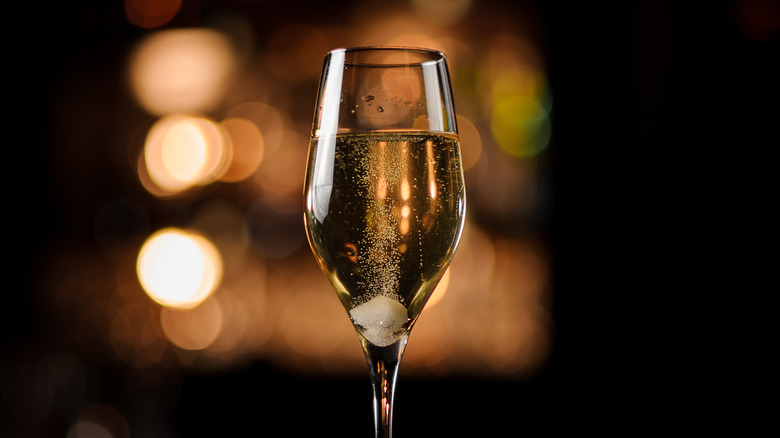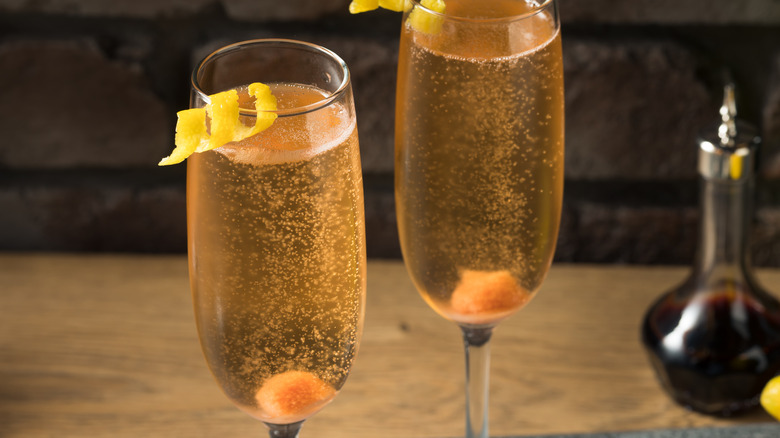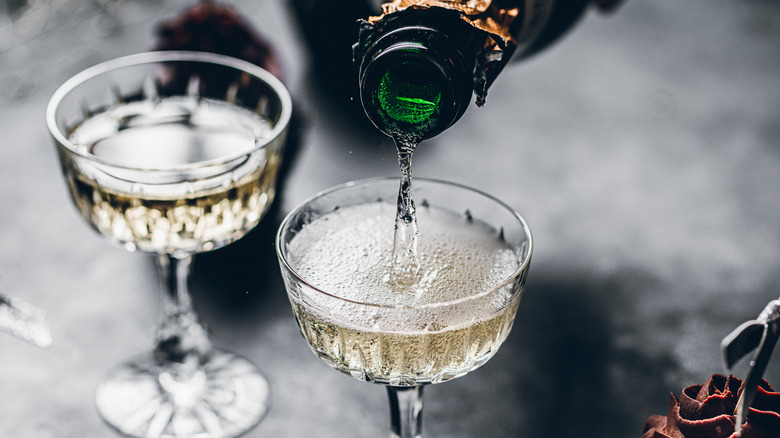The Superstition Behind Dropping Sugar Cubes In Champagne
If you've ever seen the 1987 romantic comedy "Moonstruck," you might remember when a sugar cube is dropped into a Champagne flute to celebrate an accepted marriage proposal. This famous scene isn't just a cinematic moment, though. It's a nod to an old Italian wives' tale that dropping sugar cubes into bubbly wards off bad luck and keeps the devil away.
The idea is simple: The devil doesn't want to see you happy, but with a little sweetness and symbolism, he's kept at bay. While this superstition may seem laughable to some, it's actually a widely practiced tradition. From fancy soirées to intimate celebrations with friends, adding sugar cubes to Champagne has become a common sight.
Plus, there are other explanations for why Champagne and sugar cubes have become so intertwined. Some say it's simply a way to make Champagne more palatable, transforming an often bone-dry drink into something that even non-wine drinkers can appreciate. Other, more experienced mixologists, like David Embury, believe the tradition to be downright blasphemous.
In his book "The Fine Art of Mixing Cocktails," Embury wrote that "no true Champagne lover would ever commit the sacrilege of polluting a real vintage Champagne by dunking even plain sugar" in it (via Difford's Guide). Whatever the reason, the tradition persists, and we're here to explore it with you.
The history behind the Champagne sugar cube tradition
The history behind the tradition is a tale of superstition and symbolism sweet enough to rival any bubbly libation. While the practice of dropping sugar cubes into Champagne is a common yet mysterious one (there aren't many other pop culture references outside of "Moonstruck"), there are a few fascinating theories as to how it originated.
One theory suggests that the sugar cube tradition is all about aesthetics. As the white sugar cube dissolves into the golden stir, it crackles and pops like a tiny fireworks display. Others believe the tradition began in the 19th century when adding sugar cubes became a way of pleasing those with a sweet tooth. The sweet sugar could neutralize the natural acidity of the wine, making it more enjoyable to drink.
One thing's certain, though — the first written account of the Champagne cocktail (which typically includes Champagne, a sugar cube, Angostura bitters, brandy, and a maraschino cherry or lemon twist), which appeared in the book "Panama in 1855," called for sugar. However, the most captivating theory behind the Champagne sugar cube tradition is one steeped in mysticism, and it might not even be Italian after all.
In the 17th century, Champagne was known in French as "le vin du diable," or the devil's wine. The superstition of using sugar cubes to ward off the devil, then, would be pretty fitting. Today, while the practice of dropping sugar cubes into Champagne may be viewed as a mere indulgence, it is still a fun way to add a touch of sweetness to our celebrations.
How to incorporate sugar into your Champagne cocktails
If you're feeling a bit superstitious, go ahead and drop a sugar cube into your Champagne flute. You just might get lucky. But if you're feeling a bit more adventurous, there are endless ways to sweeten up your Champagne cocktails into elevated tipples.
Three-time James Beard Award-winning food writer David Leite offers a unique, fruity twist on the classic cocktail with a recipe that asks you to dissolve the sugar in chilled blood orange juice and raspberry liqueur. Or you can make Absolut Vodka's Absolut Champeach recipe, which sticks to the original sugar cube (whether due to superstition or not) and adds Absolut Apeach and peach bitters.
For a more complex Champagne cocktail, try the classic French 75. This cocktail combines gin, lemon juice, Champagne, and a sugar cube. To really elevate this cocktail, try using elderflower liqueur in place of the sugar cube (although you won't be as lucky). The floral notes of the liqueur play perfectly with the effervescence of the Champagne.
Whether you stick to tradition or get creative, there are several ways to add a little sweetness to your Champagne cocktails (just avoid making some of the most common Champagne-drinking mistakes when you start sipping). Who knows, perhaps a little bit of that good Champagne luck will come your way!


